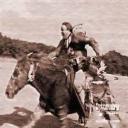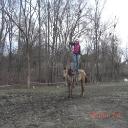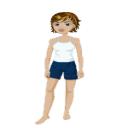Yahoo Answers is shutting down on May 4th, 2021 (Eastern Time) and beginning April 20th, 2021 (Eastern Time) the Yahoo Answers website will be in read-only mode. There will be no changes to other Yahoo properties or services, or your Yahoo account. You can find more information about the Yahoo Answers shutdown and how to download your data on this help page.
Trending News
What's the next step?
This question is posed in hopes that Smokie, Rosi or others well versed in Natural Horsemanship will answer - no kids or folks out to diss....
- It will be hard to get a full picture of my ability from here but let's see if this helps. I have been a study of NH for about 6 years now. I know how bits work and I feel I'm pretty knowledgeable about the theories of NH but I would not say I'm a 'horsewoman' yet nor am I a backyard pony owner. I've had horses for over 40 years so I'm not a kid.
- I have two young horses I've worked with in the Myler Comfort Snaffle. We have stuck in the arena because I feel we need to be well controlled at the walk, trot & canter and able to perform basic functions (stop, turn, etc) on as loose a rein as possible before graduating to other things. I've been working on collection and trying to keep their heads down at the proper place (I've learned the value of keeping the head down to maintain focus and not spook).
- Here's the question I need help with - it's two part:
1. How do I know (or what goals need to be accomplished) when it is the right time to move to a different bit or headgear?
2. Which headgear would offer the best opportunities? I have a bosal that I plan to start/have started a young horse next year. I also have Myler Combination bits that can be used with varying degrees of leverage (reins can be hooked as a snaffle, short shank and long shank). (They work like a 2-rein )
I don't want to remain in the current headgear/bit and learn later that I would have been better served at a certain point to use something else to further our learning better. I know I can stay in a snaffle forever if I want to but my goals are to ride with the lightest hands possible, have a very responsive and light horse and eventually perhaps compete in something fun like mounted shooting or competitive trail or something as well as having fun riding on the trails. I've always just gotten on and ridden, never had to go back to the arena and train as I've not had such young inexperienced horses. I want to work right with them and I'm not in an area where help is close by - in fact, I don't know where in this state I'd find anyone with the experience I seek to help me learn and teach me in person.
Thank you for any help you can give.
Demi - your comment is understandable but I believe in the Vaquero methods-I believe that a snaffle can only communicate to a certain level. I believe that if I want a quicker, more exact communication, a bit that offers more leverage and a quicker message makes a more responsive horse. While I understand and appreciate your comfort with the snaffle and staying with it, I feel a different approach is right for me.
John W - not to disagree but these are the things I can't convey in a short question. The horse DOES not simply carry it's head in a correct position or not. Head carriage affects collection and focus. I've had it proven to me and proven it to myself. The youngsters when learning tend to hold their heads high to focus on the scary stuff. When I ask them to drop their heads, they calm and focus as well as collect better so a good rider DOES need to help their horse carry it's head properly. Headgear can help affect the ability with the manner in which pressure is applied.
Folks, going bitless or staying in a snaffle is not what I want. I agree that more than a bit controls and teaches. Pressure and training all go together with it. But a bit is a tool - A builder can pound a nail with a rock or cut a board with a sharp stone too but I don't know many who would do that. Those tools would get the job done but it would take longer and the end result wouldn't be a good as if they used a good tool like a hammer and saw. I don't view a bit a 'harsh' or 'gentle' - in fact, a snaffle can be pretty harsh. A low port grazing bit is less harsh inherently so who don't people use those to start young horses? I want experience about what different bit usage has helped or hindered in growth of communication.
Hey Megz, the idea is NOT to change the bit up every week. Don't make inferences to actions that aren't there. We've been in the same snaffle for about 3 years or more now, so I don't purport the idea of changing up headgear often.
Demi and Megz, as I said above, I believe in the progression of tools to hone and better the communication available between horse and rider. Demi, I don't believe that using a harsher bit MAKES lighter hands, quite the opposite - lighter hands ALLOW use of a bit that you might view as harsher. The Vaquero doesn't use a spade bit because he MUST, he uses it because he CAN. At the point where the Vaquero uses that big spade bit, the communication between he and his horse is at the ultimate level. It appears the horse is reading the Vaquero's mind when in fact the cues are so light and subtle it appears magical. To me, that's the ultimate in communication between horse and rider. Although it would be grand to achieve it, I doubt I will get there..
Thanks folks so far, I've learned a lot about how people view bits and their use as well as how you all choose to communicate with your horses - but it's not helping me learn and go in the direction I want to go. Keep 'em coming....
5 Answers
- Anonymous1 decade agoFavorite Answer
Leverage-style headgear has often been misused, true, but it's possibilities are often misunderstood by the natural horsemanship community. People often use it to try to force a horse who needs a better foundation, but it can also allow you to have more feel with less maneuvering on your part on a well-schooled horse. It can allow you to be more fluid when you're doing things where you don't have the time to constantly be adjusting your reins (roping, mounting shooting, etc.) but you still want to be able to move from a neutral feel to contact and back fairly quickly.
Before transitioning to a tool that has a more sensitive feel, I would wait until you can do upward and downward transitions and basic turns on a draped rein, mostly off your legs and body cues through walk, trot and canter, in a fairly open area.
You can transition to a bosal or the Myler-type combo headgear, although a simpler alternative is a Billy-Allen mouthpiece with shorter shanks, maybe in the Myler series. It offers a little bit of lateral feel if needed due to the side-independent swivel action, and you could transition to a solid mouthpiece once you are riding predominately one-handed. I would not recommend a tom thumb due to the conflicting nutcracker action.
I agree that asking a horse to drop and release his neck and poll is key to keeping him off adrenaline from biomechanical standpoint, as well as encouraging him to use his back correctly for propulsion instead of bracing.
A curb bit can be a great tool to allow you to remind him to do this softly, as it already offers downward poll pressure and a inward feel.
I prefer to see my horses release their topline and release their poll to the vertical, but not flexing behind the vertical, as this creates tension as well as friction over the poll and possible ossifications there.
Keep learning and learn from everyone you can, take what works and discard the rest. Don't get caught up in people's close-mindedness, as long as you know you're doing it FOR the horse and not TO him.
Enjoy the journey.
Source(s): Horsemanship Instructor, Farrier - girtonLv 45 years ago
What season you might love to get married How lengthy do you wish engaged? Budget Do you wish to get married in a church or by means of someplace else? Then you begin calling areas round you YOu have got to make an notion of what number of(now not the visitor record but) Bridal get dressed such a lot persons get among 7 to fifteen months earlier than hand 6 months and earlier than you can't get any get dressed, a few would fee you a hurry The towards the marriage ceremony, the extra bills and not more attire you'll be able to get Choice your bridal celebration The such a lot factor might be price range Any bridal magazines might have a record to do You would move to internet web site like Wedding twine or The knot
- hopstarrLv 41 decade ago
Horses are like dogs in so much as they want to serve. They want to do what ever it is that you communicate to them. That's what training really is, making them understand what you want them to do. They enjoy being your partner and participating in whatever the activity. That said, no amout of equipment/technology will substitute for the training. I have found I get better response from a soft, flat cotton rope (five plat about 5/8" wide) tied around the bottom jaw (where a bit would normaly sit) than any other bit/headstall combination I have tried over the past 40+ years. That puts the reins in direct contact with their bottom jaw...no slack between connections of reins, bit and headstall, no bit pulling on their mouth...no steel banging on molars...not to mention the weight factor. And it doesn't interfere with grazing. Riding a light touch with your rein hand low down on their withers in combination with your other hand applying pressue on their neck where the rein touches teaches them your hand pressure and rein pressure in that spot mean the same thing. Example: Hold the reins in your left hand, resting on the withers. Rein to the left as low on the neck as you can hold the reins and at the same time press on the right side of the neck with your right hand where the rein makes contact with the neck. Then introduce knee pressure into the mix and before long you can steer with your knees while your hands are full or in a pinch with your hand...as in shooting a bow & arrow.
Also with the reins tied directly to the bottom jaw, holding their head down gets real easy to do if necessary...not to mention the amount of stop you have.
- 1 decade ago
When we start our horses the first ride is usually always done with a halter and lead rope we ride them around the pen just like that.
I ride in a bosal and after the horse is comfortable with me getting on and off, and stepping out and moving with me fine then I introduce the bosal and that is what I ride in. If I am training a horse to drive then after things are going fine in the bosal I will give it another few days to a week just to make sure the horse is completly comfortable then I introduce the driving bit.
I feel that if you know that when your horse is trained you will be riding him/her in a bosal then start the horse with the bosal, if you are going to be riding in a tom thumb then start the horse in a tom thumb. I feel that it can really confuse the horse if every couple weeks you are switching up what you are riding him in one week you are in a bosal, next a bit,next a mechanical hackamore, we feel that just throws too much at the horse at once. When we train horses for clients we find out what the owner prefers to ride in and that is what we use on the horse once we start riding them.
Source(s): Gentle Touch Horse Training, a gentle touch makes a gentle horse - How do you think about the answers? You can sign in to vote the answer.
- Demi leighLv 51 decade ago
Hi, well I just have to say that if your horses are working well in a snaffle which is the gentlest bit why change it? Moving them on to a harsher bit will not make you have lighter hands. I ride dressage and have very light hands with just a plain snaffle. Light hands depend on the rider, not the bit the horse has.





